Of all aspects of bodybuilding training, stretching is the one part that is most often ignored by the majority of people. It is just one of those things that seems to get pushed off to the side as not that important. You probably say to yourself in the back of your mind…
“I know I should stretch… blah, blah, blah… but why bother? I just want to get big…”
But did you know that stretching can actually help speed up your muscle growth?!
In this blog post you’re going to learn several unique stretching exercises that are designed to stretch the connective tissue which surrounds the muscles, and there by expand the fascia and enable the muscles to grow bigger and stronger.
The connective tissues that surround the muscles is very tuff and hugs the muscle fibers tight. This can actually constrict expansion and growth. For muscle hypertrophy to occur the surrounding fascia needs to be stretched and become more pliable in order to give the muscle fibers room enough to expand grow bigger.
Even if you haven’t seriously focused on stretching before, the muscle mass that you have built up to this point came about from the stretching and expanding of the muscles encasing tissue. During your workouts when blood is being pumped into the muscles, the surrounding connective tissues are being stretched, that’s why you get that tight feeling we call “the pump”.
The ideal time to stretch for increasing muscle mass is right after you’ve trained a particular bodypart and the muscles are “pumped up” and feeling tight.
At this stage the connective tissues are already being stretched from the blood volume in the muscles, and then by manually stretching the muscles as well, you get a double whammy effect and this really increases the muscle fibers growth potential.
There are basically two types of stretching that you can do to expand the fasical and surrounding connective tissue, active stretching with weights and static stretching.
Active Stretching With Weights
Active Stretching with weights is where you include exercises in your routine that work the muscles in the fully stretched range of motion. Some good examples of this include:
– Dumbbell Flyes for chest.
– Pull Overs for the lats.
– Preacher Curls for the biceps.
– Overhead Tricep Extensions for the triceps.
– Shrugs for the shoulders / traps.
– Stiff Leg Deadlifts from the hamstrings and lower back.
– Bench Lunges for the quads.
– Standing Calve Raises for the calve.
Now there are plenty of other exercises that I could add to the list of active stretching moves. But I think you get the idea. Each of these exercises allow you to lower the weight all the way down and really feel a deep stretch in the muscles at the bottom of each rep. To really emphasis the stretch you can hold the bottom position of each rep for a couple seconds while you do these exercises in your workouts.
Static Stretching
Static stretching is the more traditional form of stretching that most people are familiar with. For example, bending over and touching your toes is a good static stretch for the hamstrings and lower back. With static stretching you want to go to the point of discomfort and then hold the stretch for 30-60 seconds.
Ease into it at first, don’t rush into it and push yourself to the point of excruciating pain and risk pulling or tearing the muscles. As you become more accustomed to stretching your pain threshold will improve and you’ll be able to hold the stretches longer and stretch deeper.
Here are some static stretches that you can do at the end of each bodypart workout.
– Chest, shoulders, biceps.
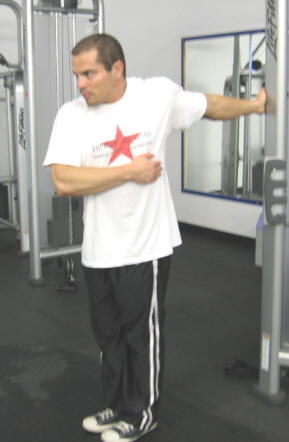
Extend your arm and hold a poll or some other sturdy stationary object with one hand. Then rotate your body away while keeping your posture upright. Keep going until you feel a good stretch in the chest, shoulders, and biceps. Hold this for 30-60 seconds and then repeat with the other arm. Do this stretch at least twice for each side.
– Lats, chest, biceps, triceps, rear delts, and upper back.
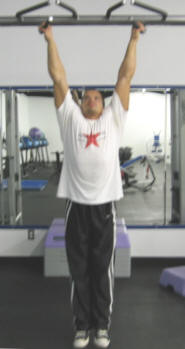
This stretch is quite simple, just grab a chin up bar and hang from it for as long as your grip will hold out. You’ll pretty much feel the stretch throughout the entire upper torso. You can repeat several times with different grips (i.e. wide, narrow, underhand, overhand, etc.). This is one of my personal favorite stretches that I do often.
– Lats and chest.
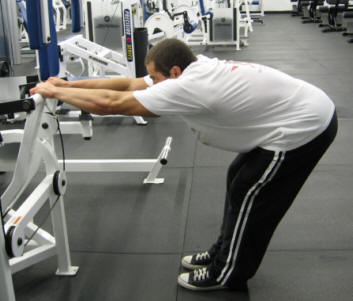
Grab a bar or machine handle that is about waist high. Simply extend back as shown in the picture until you feel a good stretch in the lats and chest. Hold this for 30-60 seconds, take a quick rest and then repeat again.
– Front Delts
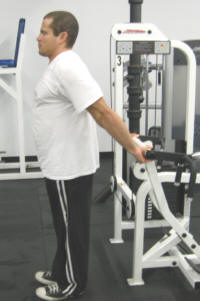
Similar to the previous exercise, using a bar or machine handle that is waist high, grab it from behind, palms facing backwards, and step forward until your feel the stretch in your front deltoids. Hold this for 30-60 seconds, take a quick rest and then repeat again.
– Triceps and lats
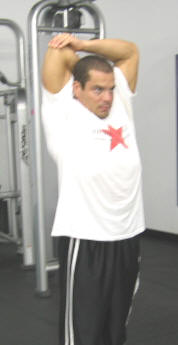 |
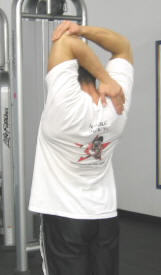 |
Extend both arms overhead, then bend one arm down behind your head and grab your elbow with the opposite hand. Pull your elbow until you feel the stretch in your tricep and lat. Hold this for 30-60 seconds and then repeat with the other arm. Do this stretch at least twice for each side.
– Quadriceps
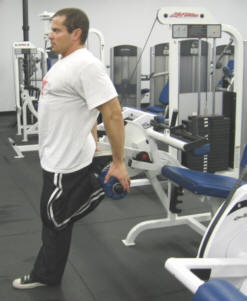
Using a leg extension or seated leg curl machine, set the foot roller pad so that it is just lower then the height of your butt. Put the pin in the full weight stack so that the pad doesn’t move. Then hook your foot over the pad as shown in the picture. And lean back and down until you feel the stretch throughout the quads. Hold this for 30-60 seconds and then repeat with the other leg. Do this stretch at least twice for each side.
– Hamstrings
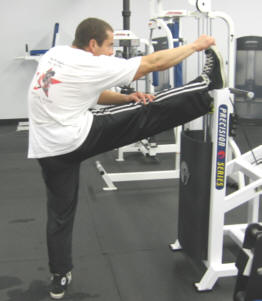
Extend your leg on a weight machine, rack, or some other object that is a bit higher then waist height. Straighten your leg and lean forward until you feel the stretch in the hamstrings. Try to grab your toes if you flexible enough, if not then just reach out as far as you can. Hold this for 30-60 seconds and then repeat with the other leg. Do this stretch at least twice for each side.
– Lower Back and Hamstrings
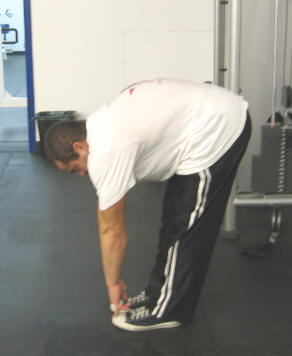
This is pretty straight forward, just bend over with your legs straight and touch your toes. Hold this for 30-60 seconds, take a quick rest and then repeat again.
Well there you have it… some simple stretches that you can incorporate into your workouts. The way you would do them is after you train a particular bodypart you would go through the above list of stretches and perform the ones that stretch the muscles you just worked. You DO NOT have to do each and every stretch after every workout. Just stretch the muscles that you trained. And then as you go through your workout cycle you’ll train and stretch each and every muscle group.
The actual time commitment to doing these stretches is minimal we are only talking about 10 minutes at most at the end of your weight training. But I can guarantee you that if do these stretches on a regular basis you’ll see noticeable improvements in your muscle fullness and separation within the next 6-8 weeks.
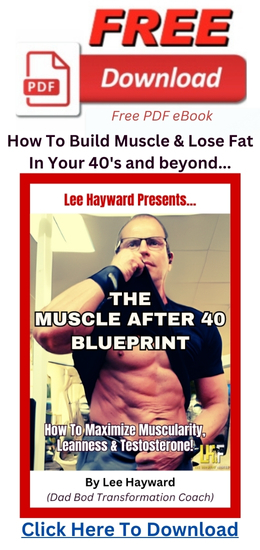
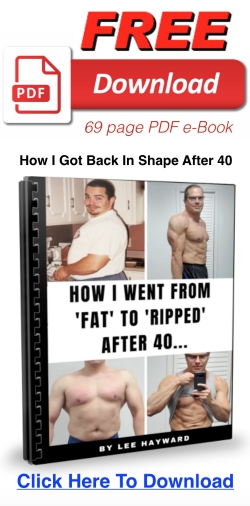

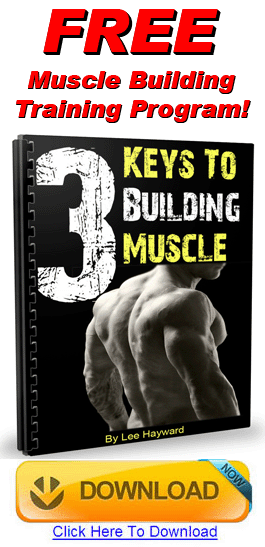

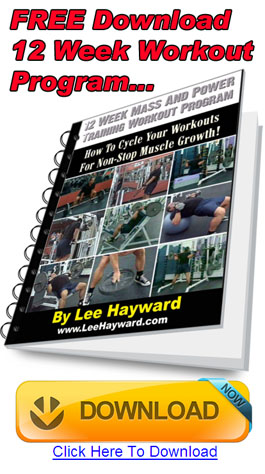

50 Comments
Darshan Weerasinge
Very practical and useul. I have dome a similar rotuine foryears and have reaped great benefits. Thanks guys!
Joseph
Right on as usual Lee. Sometimes I think your reading my journal. In the last month or so I’ve been incorporating stretching into my routine. I’ll pump the muscle good with for example a bench press for chest and then superset it with a stretching excersise such as butterflys, it’s been working well. I only had a couple of stretch routines because I wasn’t fimiliar with many of the stretching techniques so this has helped me out. Thanks again your doing a great job.
Stefan Radu
Great article, Lee. I always skipped streching, even though I knew it was important. But now I will try these streches at the end of my workout.
samuel surender kumar
thanks lee for sharing.
ian marsh
Hi Lee,
Training at the gym trying to bulk have roped in a few friends as well , one thing one of my friends is finding that when we are doing work on Biceps i.e preacher curls etc he seems to get a little bit of a work out on his biceps but feels more on his forearm muscle,is there something we are not doing that could rectify this.
Many Thanks
Ian
Alex
Good advice, i have allways done it and find it hard to understand how everyone else isnt..
Apart from stretching the muscles i worked after my workout i have 2 static stretching classes every week, where with a classified trainer i stretch every single muscle in the right order.. our bodies have lots of muscles, not just 6..
Incorporating that hold you wrote about on the stretching position during the exercises also helps a lot and is very good advice, because you are stretching with added weight and because doing it you are using the full range of motion and working the muscle exactly at the point where it is weaker (fully stretched position).
Keep it up Lee !!
ian marsh
Hi All,
anyone got any advice on my previous question on biceps any advice would be gratefully appreciated
Many Thanks
Ian
Alex
It may be that he is developing tennis elbow, wich makes the elbow very sensitive to any supinated curling.. the slight pain in the elbow is enough to not being able to work and feel the biceps..
Using the EZ bar instead of the straight one seems to help and also focusing on hammer curls for a while untill it heals.
There are some exercises that can also help the healing and strengthning of the elbows wich Lee has made some videos on, just search..
I hope this helps..
ian marsh,
ian marsh
Alex,
Many thanks for your help Alex in on Saturday will try this and look for the videos
Ian
Michael Pearson
You have touched on a great point Lee. Stretching should be part of any routing, as well as a warm-up. The stretching can be part of the cool down, along with 10 minutes of cardio. When you stretch your muscles they become shortened. If you do not actively stretch them out you risk poor posture, such as rounded shoulders and an anterior tilt. Great stretching exercises are lat pulldowns, tricep pushdowns and low rows. Go slow and hold the stretch portion for a count of two and it will enhance your training goals and help your recovery process.
J
Hi Ian. Im not Lee but I find it helpful to use extension with your wrists when performing curls if you are feeling too much in your forearms. Just keep the extension in the wrists through the entire movement. You probably cant go as heavy as normal but it might help with the issue. Good Luck.
J
ian marsh,
leehayward
==============
It’s actually normal to work the forearms hard whenever you do any bicep curl variation. But I’ve got a YouTube video that covers the preacher curl in more detail. It shows how to position your body to better activate the biceps during the lift.
You should check it out at:
Joseph
leehayward,
how do you get your picture on your thread like that Lee? I have a pic on my gmail account but it’s not coming through to this one for some reason.
Ray
What about yoga? Recognizing that there are only a certain number of days in a week and that a training session should stay in the 45-60min area, would you get the same growth benefit from doing 1 day of a 30-60min yoga on a rest day as you would by spending that 10min each training day?
I’m really curious as to which would be more efficient.
Thanks,
Ray
Roland
Your No.1 health&fitness tip is the hanging from a pull up bar stretch. Seriously. Everyone should do that.
eddie
hi lee i always do stretching in my work out the ones i see you do i feel great after it good luck
Don
Thanks, Lee, this is a very useful post! I’ve known I should be stretching more but had no idea how to do it. Now I have some very good ideas!
Shompz
Hey Lee, what’s ur opinion in regards to stretching between sets?
Thanx
Shompz
Chuck S
I don’t see your picture doing yoga, Lee lol. I know – you’ll post your picture as soon as I send in mine.
ram
Hi lee ,after long time i want to starts my workout n is it possible to work only for Biceps sholder n back , and loss some wait but not uper body shape
pls advise me Thanks
Rk
edward
WHY WAS MY POST DELETED? I WAS THE FIRST POSTER. DOES IT HAS TO BE ‘ HI LEE I AM A HUGE FAN OF YOU…’ ALL THE TIME ? CANT YOU ACCEPT TRUTH FOR A CHANGE?
I AM SURE AFTER DELETING THIS POST YOU WILL BE BLOCKING MY IP ADDRESS TOO..
HAHAHHA WHAT A JA** AS*.
leehayward
edward,
Your post was deleted because I’m here trying to share some advice to my followers and you are calling me a cheap rip off for posting an article about stretching.
Just to let you know stretching has been around for a very long time, even before Dante came on the scene. For example, John Parrillo has been a huge advocate of stretching to help bodybuilders for over 20 years. Steve Holman has been recommending stretching exercises for many years as well. Even back in the pumping iron days folks incorporated stretching exercises in their workouts.
So I have no idea where it originally came about, but that’s not the point, I never claimed to invent anything, I’m just passing along some training advice to help out my followers.
If you want to post and contribute to the blog that’s fine, I will welcome your posts just like I do anyone else’s. But if you just want to stir up crap and be ignorant then those posts will be deleted.
leehayward
leehayward
======================
I personally like to save the stretching for after my weight training workouts. There’s a school of thought that says stretching can temporarily reduce power output. But if you want to do some easy stretches between sets that’s fine. However, I’d recommend doing most of your stretching after training.
leehayward
=================
Any stretching is better than no stretching. But for bodybuilding purposes I would recommend stretching after training just like I covered in this blog post.
leehayward
==================
You need to sign up at: http://en.gravatar.com this will allow your avatar to show up on word press blog posts.
Al
Lee:
Awesome tips as usual. Some of the stretches I was already doing. A few of the ones you showed I’ve incorporated at the end of weight training. Thanks DUDE your the “BOMB”!
James Mc Donagh
Hey Lee, I have never really stretched that much in the past before a weights session, however I have lately began stretching, and I have found it to be extremely useful. Thanks for all the great tips and blogs.
ochieng
Great article lee.
Need advice on how to strengthen an injured neck & upper chest sustained from a heavy knock, like from someone over 100kgs.
Many thanks.
leehayward
=========
For serious neck injuries you should check with a physio therapist or a chiropractor first to make sure there is no serious damage done before resuming regular training.
But I do have an article about neck training up on my old site at: http://www.leehayward.com/neck.htm
shortstack
Awsome stuff !! I havr just recently found this website an have watched a few of your videos an i like the way you present things .. so since my memory is rather pathetic an i hav forgotten so many lil things an tricks i learned , i trusted this page especialy to help me get back into the game.. thank you Lee for being bad ass. I cant wait to stretch after my routine tomarow ha thanks man 🙂
Chuck S
I believe tht the reason to do static stretches AFTER exercising is that the muscles and ligaments are warmed up after exercising and stretch better and safer. Doing static stretches before exercising can damage something. I would guess that you couldn’t stretch as far, either (unless you break something lol).
I do some of the stretches on my stairway – stand at the bottom and put my foot on a step.
Sean McKenzie
Thanks for the great tips, once again, Lee!
Sean
SAMIR
TRUE! & RIGHT AS USUAL. A VERY VALUABLE ARTICLE FOR ALL WEIGHT LIFTING FOLKS!
aaron
Your doing a great job lee, keep up the good work!
Mike
Good stuff Lee.
How many times do you see people doing stretches before they have even warmed up properly? Just a disaster waiting to happen.
Not so much now, but when I was a younger man and lifted quite a bit more weight than I do now, I found it also reduced the soreness I experienced over the next couple of days.
Spacelawyer
Thanks a lot, Lee. This seems to comport with the protocol of Parrillo who is a huge zealot for fascial stretching but demanding same AFTER each exercise, hence, proximate to the particular pump. Do you agree and also about Parrillo’s MCT advocacy? God bless you and yours.
Chalky
Hi lee becoming a big fan a few months ago I had lower back problems it was so painfull i could hardly walk caused by not stretching (warning down) . This is a issue that is never focused on as all we want to do is pumping iron……GOOD TOPIC
adam
great advise as usual Lee. i will add some to my training thanks
leehayward
====================
I haven’t really used MCT’s myself. When it comes to supplementing with fats I’m more of a fan of EFA’s such as fish oil. I take that stuff every single day.
Miles
Hi Lee, I was wondering if you are not able to touch your toes with straight legs is it better to bend your legs to touch your toes or keep your legs straight and reach as close as you can towards the ground?
Cheers
Rob Winters
Good and usable tips here Lee.I’m pretty good with warming up etc.before i work out but like most i most often neglect this aspect.Thanks for reminding me 🙂
Steven
Thanks Lee!!! Keep the emails coming brother.
Alexander Duncan
i think now it is time to feel awesome, i have been stretching after each workout since i started XD
Etsuko Kievit
Deficiency of Testerone is blamed for multiple ailments. Lack of sexdrive, obesity, hair-growth, voice tone, impotence, erectile dysfunction, sadness, etc are all connected with Testerone and lack of it affects all these areas.
Catherine
I would do the 10 min. stretching routine after your workout whether or not you incorporate yoga into your overall fitness/bodybuilding routine. I do yoga 3 x per week but I still stretch the muscles I’ve trained after a weight session.
Ray,
Frank
Great job as usual. I just like the way that you explain procedures simple and to the point in common ordinary English.
greg guard
good points and examples.
Alan
I am not an expert, but do regular yoga and do this stretch a lot. They get us to do it with bent knees a lot. Maybe more than straight legs. And sometimes different degrees, like really bent and putting palms on floor. I find that bending a bit isolates the body of the hamstrings if inflexible, and then work to straighten a little from the bent position, and feel it in the hamstrings. You will not be able to get all the way up if inflexible, which is fine, as it is about feeling the stretch. I think that bending the legs more may get in to the stretching the lower-back more, as well. But straight legs, you are probably getting the connective ligament tissue of behind the knees, which is great. One can do the same thing sitting on the floor with straight legs out in front, and reaching for the toes. If you can’t reach the toes, that is fine and gets the hamstrings. But then use a band around the balls of the feet, bringing the feet back and it will get the calves going with the hamstrings. So it depends what you want to stretch. Do it both way, bent knees, and straight, to isolate different parts. But I’m no expert, so maybe a little inaccurate with one or two things here. But just what I’ve experienced with my bit of yoga experience.
Miles,
Andrei Marius
Great article! Everything is practical and useful. Keep up the good work!